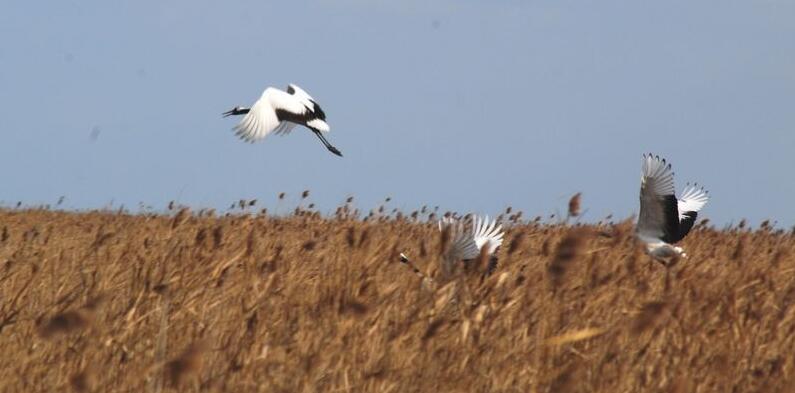Yancheng National Nature Reserve belongs to the National Environmental Protection Agency. The reserve was established in 1983 as a provincial nature reserve and upgraded to national level in 1992. In November 1992, it joined UNESCO’s International Man and Biosphere Program which uses multiple disciplines to sustainably safeguard threatened ecosystems and human livelihoods. In 1996 it was included in the Northeast Asia Crane Protection Network.
Located in the east part of Jiangsu province, the Yancheng Wetland National Nature Reserve is the largest coastal wetland nature reserve in the east of China, covering the coastal areas of Sheyang, Dafeng, Binhai, Xiangshui, and Dongtai counties and facing the south of the Yellow Sea. The wave collision and tidal effect of the Yellow Sea and the East China Sea combined with the sediment from the ancient Yellow River Delta and the Yangtze River Delta form a silt plain coast which is today’s reserve. After a long history of evolution, the wetlands basin was formed. In 2013, the authorized total area is 247,300 hectares, of which the core area is 22,600 hectares and the experimental area is 168,000 hectares. The primary goal of the nature reserve is to protect the fragile tidal wetlands ecosystem and a variety of rare birds, with a main focus on the endangered Grus japonenis, or red-crowned crane.
The reserve is exceptionally rich in wildlife including 402 varieties of birds, 26 kinds of amphibians and reptiles, 284 species of fish, and 31 kinds of mammals. Among them there are 14 wildlife species that are under first class state protection. These are the red-crowned crane, hooded crane, Siberian crane, oriental white stork, black stork, Chinese merganser, leaving gull, great bustard, imperial eagle, golden eagle, white-tailed sea eagles, elk, and sturgeon. There are 85 kinds of wild species under second class state protection, such as river deer, black-faced spoonbill, whooper swans, little greenshank, mandarin duck, grey crane, and many others.
Alongside the reserves abundance in fauna is a corresponding diversity in flora, with a total of 450 kinds of plants. The main vegetation types are plantation, salt meadow, marsh vegetation, aquatic vegetation, rare earth and abandoned vegetation. The native plant species are found mainly in the salt meadow, including reed meadow, imperata meadow, a large spike zoysia meadow, deer hair meadow and mixed meadow. The primary vegetation throughout the nature reserve comprises of reeds, deer hair, Suaeda and Spartina.
Yancheng Nature Reserve is a vital wintering ground for the red-crowned crane, a flagship species in this region. In late October they successfully migrate long distances to the reserve for winter from their breeding grounds in northeast China and along the Russian border to the reserve. In February or early March they return home. During the harsh cold month of January, they often feed in flocks to maintain warmth.
In the center of the nature reserve, red-owned cranes forage primarily in deeper waters than other crane species, and are often found in various salt or freshwater marshes, rice paddies, and cultivated fields. Years of observation data showed the distribution of red-crowned cranes had gradually altered over time from its original large habitat and transitioned to more island locations, reflecting the deterioration and fragmentation of their former territorial boundaries. Wherever they forage, they would return to the edge of Alkaline pond to avoid predators at night.
Aside from red-crowned cranes, numerous other bird species can be found in the reserve. The predominant types are gray cranes and bean geese, but also include egrets, cormorants, white storks, magpie geese, and ducks. Thousands of bean geese and hundreds of grey cranes are often seen jointly feeding in the same wheat fields. They are mainly clustered and active within the buffer zone, an area for the birds in the wetlands, protecting them from human disturbances. Compared with the red-crowned cranes, the grey cranes are more alert and wary. They create a 500 meter perimeter for security and take off in flocks if they feel threatened or are approached by perceived predators. Red-crowned cranes tent to keep a safe distance from humans.
Since the establishment of the Yancheng Nature Reserve, generations of staff have made immense personal sacrifices and worked diligently to protect the beloved red-crowned cranes, to the extent of some even losing their lives. The 1980,s popular song “Red-Crowned Crane Story” described the true story of Xu Xiujuan, a staff member of the reserve who died tragically while attempting to save the red-crowned crane. Its poignant melodies and touching lyrics struck a nation-wide chord in everyone’s hearts. Nestled among the green, leafy willows at the center of the reserve, Xu’s grave rests peacefully. The author of this article came to visit her tomb, bowing deeply to express respect and appreciation. Suddenly a lone, male elk appeared among the reeds. It was the only elk the author observed in the reserve, quite possibly nature’s silent tribute to Xu and her sacrifice.
Although the government and the staff of I reserve have made great efforts to protect this fragile ecosystem, the current level of protection for red-crowned cranes is not adequate. There was a vast contradiction between protection and utilization of coastal economic development between 1988 and 2000 to include reclamation of portions of the wetlands for agriculture, industry, and to provide embankments for fish farming ponds. With the development of these service sectors, the water became polluted, and unfortunately the multiple management offices (forestry, water conservancy, environmental protection, land reclamation, and fishing) are finding it difficult to reach a balance between economic development and environmental conservation. The rapid propagation of Spartina anglica, common-cord grass, an alien or non-native species, reduces the suitable foraging and living habitat for red-crowned cranes. All the above factors have lead to the decrease and degradation of their delicate habitat. The wintering population of red-crowned cranes in the nature reserve dropped from 1,110 in 1999 to the current number of approximately 500. Much needs to be done to protect this beautiful and iconic species and its habitat.












